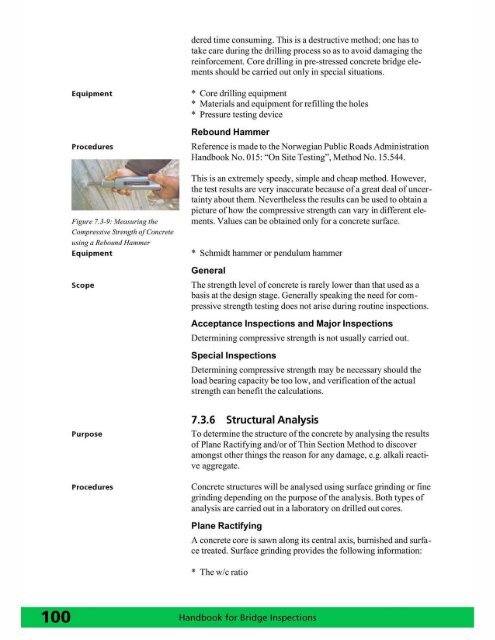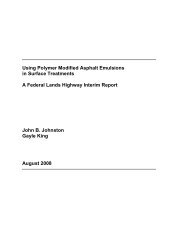Handbook for Bridge Inspections - TSP2
Handbook for Bridge Inspections - TSP2
Handbook for Bridge Inspections - TSP2
Create successful ePaper yourself
Turn your PDF publications into a flip-book with our unique Google optimized e-Paper software.
dered time consuming. This is a destructive method; one has to<br />
take care du ring the dri ll ing process so as to avoid damaging the<br />
rein<strong>for</strong>cement. Core dril ling in pre-stressed concrete bridge elements<br />
should be carried out only in special situations.<br />
Equipment<br />
* Core drilling equipment<br />
* Materials and equipment fo r refilling the hol es<br />
* Pressure testing device<br />
Rebound Hammer<br />
Procedures<br />
Reference is made to the Norwegian Public Roads Administration<br />
<strong>Handbook</strong> No. 0 15: "On Site Testing", Method No. 15.544.<br />
Figure 7,3-9: Measurillg the<br />
Compressive Strength o/ Col/crete<br />
!lsillg a Rebowui flammer<br />
Equipment<br />
This is an extremely speedy, simple and cheap method. However,<br />
the test results are very inaccurate because of a great deal ofuncertainty<br />
about them. Nevertheless the results can be used to obtain a<br />
picture of how the compressive strength can vary in different ele-.<br />
ments. Values can be obtained only <strong>for</strong> a concrete surface.<br />
* Schmidt hammer or pendulum hammer<br />
General<br />
Scope<br />
The strength level of concrete is rarely lower than that used as a<br />
basis at the design stage. Generally speaking the need <strong>for</strong> compressive<br />
strength testi ng does not arise during routine inspections.<br />
Acceptance <strong>Inspections</strong> and Major <strong>Inspections</strong><br />
Determining compressive strength is not usual ly carried out.<br />
Special <strong>Inspections</strong><br />
Determining compressive strength may be necessary should the<br />
load bearing capacity be too low, and verification of the actual<br />
strength can benefit the calculati ons.<br />
Purpose<br />
Procedures<br />
7.3.6 Structural Analysis<br />
To determine the structure of the concrete by analysi ng the results<br />
of Plane Ractify ing and/or of Thin Section Method to discover<br />
amongst other things the reason <strong>for</strong> any damage, e.g. alka li reactive<br />
aggregate.<br />
Concrete structures will be analysed using surface gri nding or fine<br />
grinding depending on the purpose of the analysis. Both types of<br />
anal ysis are carried out in a laboratory on drilled out cores.<br />
Plane Ractifying<br />
A concrete core is sawn along its central axis, burnished and surface<br />
treated. Surface grinding providcs the following in<strong>for</strong>mation:<br />
* The \VIc ratio
















